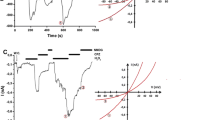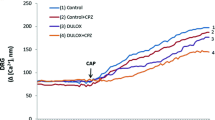Abstract
Glutathione (GSH) is the most abundant thiol antioxidant in mammalian cells and maintains thiol redox in the cells. GSH depletion has been implicated in the neurobiology of sensory neurons. Because the mechanisms that lead to melastatin-like transient receptor potential 2 (TRPM2) channel activation/inhibition in response to glutathione depletion and 2-aminoethyldiphenyl borinate (2-APB) administration are not understood, we tested the effects of 2-APB and GSH on oxidative stress and buthionine sulfoximine (BSO)-induced TRPM2 cation channel currents in dorsal root ganglion (DRG) neurons of rats. DRG neurons were freshly isolated from rats and the neurons were incubated for 24 h with BSO. In whole-cell patch clamp experiments, TRPM2 currents in the rat were consistently induced by H2O2 or BSO. TRPM2 channels current densities and cytosolic free Ca2+ content of the neurons were higher in BSO and H2O2 groups than in control. However, the current densities and cytosolic Ca2+ release were also higher in the BSO + H2O2 group than in the H2O2 alone. When intracellular GSH is introduced by pipette TRPM2 channel currents were not activated by BSO, H2O2 or rotenone. BSO and H2O2-induced Ca2+ gates were blocked by the 2-APB. Glutathione peroxidase activity, lipid peroxidation and GSH levels in the DRG neurons were also modulated by GSH and 2-APB inhibition. In conclusion, we observed the protective role of 2-APB and GSH on Ca2+ influx through a TRPM2 channel in intracellular GSH depleted DRG neurons. Since cytosolic glutathione depletion is a common feature of neuropathic pain and diseases of sensory neuron, our findings are relevant to the etiology of neuropathology in DRG neurons.





Similar content being viewed by others
References
Altinkilic S, Nazıroğlu M, Uğuz AC, Özcankaya R (2010) Fish oil and antipsychotic risperidone modulates oxidative stress in PC12 cell line membranes through regulation of calcium ion release and antioxidant system. J Membr Biol 235:211–218
Anderson ME (1998) Glutathione: an overview of biosynthesis and modulation. Chem Biol Interac 111–112:1–14
Bai JZ, Lipski J (2010) Differential expression of TRPM2 and TRPV4 channels and their potential role in oxidative stress-induced cell death in organotypic hippocampal culture. Neurotoxicology 31:204–214
Bao L, Avshalumov MV, Rice ME (2005) Partial mitochondrial inhibition causes striatal dopamine release suppression and medium spiny neuron depolarization via H2O2 elevation, not ATP depletion. J Neurosci 26:10029–10040
Bove J, Prou D, Perier C, Przedborski S (2005) Toxin-induced models of Parkinson’s disease. NeuroRx 2:484–494
Bubber P, Tang J, Haroutunian V, Xu H, Davis KL, Blass JP, Gibson GE (2004) Mitochondrial enzymes in schizophrenia. J Mol Neurosci 24:315–321
Cabungcal JH, Preissmann D, Delseth C, Cuénod M, Do KQ, Schenk F (2007) Transitory glutathione deficit during brain development induces cognitive impairment in juvenile and adult rats: relevance to schizophrenia. Neurobiol Dis 26:634–645
Clapham DE (2007) SnapShot: mammalian TRP channels. Cell 129:220
Espino J, Mediero M, Bejarano I, Lozano GM, Ortiz A, García JF, Rodríguez AB, JçA Pariente (2009) Reduced levels of intracellular calcium releasing in spermatozoa from asthenozoospermic patients. Rep Biol Endocrinol 7:11
Fonfria E, Marshall IC, Boyfield I, Skaper SD, Hughes JP, Owen DE, Zhang W, Miller BA, Benham CD, McNulty S (2005) Amyloid beta-peptide(1–42) and hydrogen peroxide-induced toxicity are mediated by TRPM2 in rat primary striatal cultures. J Neurochem 95:715–723
Freestone PS, Chung KK, Guatteo E, Mercuri NB, Nicholson LF, Lipski J (2009) Acute action of rotenone on nigral dopaminergic neurons—involvement of reactive oxygen species and disruption of Ca2+ homeostasis. Eur J Neurosci 30:1849–1859
Grupe M, Myers G, Penner R, Fleig A (2010) Activation of store-operated I(CRAC) by hydrogen peroxide. Cell Calcium 48:1–9
Grynkiewicz C, Poenie M, Tsien RY (1985) A new generation of Ca2+ indicators with greatly improved fluorescence properties. J Biol Chem 260:3440–3450
Hajnóczky G, Csordás G, Das S, Garcia-Perez C, Saotome M, Sinha Roy S, Yi M (2006) Mitochondrial calcium signaling and cell death: approaches for assessing the role of mitochondrial Ca2+ uptake in apoptosis. Cell Calcium 40:553–560
Halliwell B (2006) Oxidative stress and neurodegeneration: where are we now? J Neurochem 97:1634–1658
Hara Y, Wakamori M, Ishii M, Maeno E, Nishida M, Yoshida T, Yamada H, Shimizu S, Mori E, Kudoh J, Shimizu N, Kurose H, Okada Y, Imoto K, Mori Y (2002) LTRPC2 Ca2+-permeable channel activated by changes in redox status confers susceptibility to cell death. Mol Cell 9:163–173
Ishii M, Shimizu S, Hara Y, Hagiwara T, Miyazaki A, Mori Y, Kiuchi Y (2006) Intracellular-produced hydroxyl radical mediates H2O2-induced Ca2+ influx and cell death in rat beta-cell line RIN-5F. Cell Calcium 39:487–494
Kühn FJ, Kühn C, Naziroglu M, Lückhoff A (2009) Role of an N-terminal splice segment in the activation of the cation channel TRPM2 by ADP-ribose and hydrogen peroxide. Neurochem Res 34:227–233
Lawrence RA, Burk RF (1976) Glutathione peroxidase activity in selenium-deficient rat liver. Biochim Biophys Res Commun 71:952–958
Lowry OH, Rosebrough NJ, Farr AL, Randall RJ (1951) Protein measurement with the Folin-phenol reagent. J Biol Chem 193:265–275
Nazıroğlu M (2007) New molecular mechanisms on the activation of TRPM2 channels by oxidative stress and ADP-ribose. Neurochem Res 32:1990–2001
Nazıroğlu M (2009) Role of selenium on calcium signaling and oxidative stress-induced molecular pathways in epilepsy. Neurochem Res 34:2181–2191
Nazıroğlu M (2011) TRPM2 cation channels, oxidative stress and neurological diseases: where are we now? Neurochem Res 36:355–366
Nazıroğlu M, Lückhoff A (2008a) Effects of antioxidants on calcium influx through TRPM2 channels in transfected cells activated by hydrogen peroxide. J Neurol Sci 270:152–158
Nazıroğlu M, Lückhoff A (2008b) A calcium influx pathway regulated separately by oxidative stress and ADP-Ribose in TRPM2 channels: single channel events. Neurochem Res 33:1256–1262
Nazıroğlu M, Kutluhan S, Yılmaz M (2008) Selenium and topiramate modulates oxidative stress and Ca2+-ATPase, EEG records in pentylentetrazol-induced brain seizures in rats. J Membr Biol 225:39–49
Nazıroğlu M, Özgül M, Çelik Ö, Çiğ B, Sözbir E (2011) Aminoethoxydiphenyl borate and flufenamic acid inhibit Ca2+ influx through TRPM2 channels in rat dorsal root ganglion neurons activated by ADP-ribose and rotenone. J Membr Biol 241:69–75
Placer ZA, Cushman L, Johnson BC (1966) Estimation of products of lipid peroxidation (malonyl dialdehyde) in biological fluids. Anal Biochem 16:359–364
Putney JW Jr, McKay RR (1999) Capacitative calcium entry. Bioessays 21:38–46
Salazar M, Pariente JA, Salido GM, González A (2008a) Ebselen increases cytosolic free Ca2+ concentration, stimulates glutamate release and increases GFAP content in rat hippocampal astrocytes. Toxicology 244:280–291
Salazar M, Pariente JA, Salido GM, González A (2008b) Ethanol induces glutamate secretion by Ca2+ mobilization and ROS generation in rat hippocampal astrocytes. Neurochem Int 52:1061–1067
Sechi G, Deledda MG, Bua G, Satta WM, Deiana GA, Pes GM, Rosati G (1996) Reduced intravenous glutathione in the treatment of early Parkinson’s disease. Prog Neuropsychopharmacol Biol Psychiatry 20:1159–1170
Sedlak J, Lindsay RHC (1968) Estimation of total, protein bound and non-protein sulfhydryl groups in tissue with Ellmann’s reagent. Anal Biochem 25:192–205
Shimizu E, Hashimoto K, Komatsu N, Iyo M (2002) Roles of endogenous glutathione levels on 6-hydroxydopamine-induced apoptotic neuronal cell death in human neuroblastoma SK-N-SH cells. Neuropharmacology 43:434–443
Sian J, Dexter DT, Lees AJ, Daniel S, Agid Y, Javoy-Agid F, Jenner P, Marsden CD (1994) Alterations in glutathione levels in Parkinson’s disease and other neurodegenerative disorders affecting basal ganglia. Ann Neurol 36:348–355
Staaf S, Franck MC, Marmigère F, Mattsson JP, Ernfors P (2010) Dynamic expression of the TRPM subgroup of ion channels in developing mouse sensory neurons. Gene Exp Patterns 10:65–74
Steullet P, Neijt HC, Cuénod M, Do KQ (2006) Synaptic plasticity impairment and hypofunction of NMDA receptors induced by glutathione deficit: relevance to schizophrenia. Neuroscience 137:807–819
Togashi K, Inada H, Tominaga M (2008) Inhibition of the transient receptor potential cation channel TRPM2 by 2-aminoethoxydiphenyl borate (2-APB). Br J Pharmacol 153:1324–1330
Uğuz AC, Nazıroğlu M, Espino J, Bejarano I, González D, Rodríguez AB, Pariente JA (2009) Selenium modulates oxidative stress-induced cell apoptosis in human myeloid HL-60 cells via regulation of caspase-3, -9 and calcium influx. J Membr Biol 232:15–23
Wehage E, Eisfeld J, Heiner I, Jüngling E, Zitt C, Lückhoff A (2002) Activation of the cation channel long transient receptor potential channel 2 (LTRPC2) by hydrogen peroxide. A splice variant reveals a mode of activation independent of ADP-ribose. J Biol Chem 277:23150–23156
Whanger PD (2001) Selenium and the brain: a review. Nutr Neurosci 4:81–97
Acknowledgments
There is no financial support for the study. There is no conflict of interest in the current study. The authors wish to thank Dr. Peter J. Butterworth (Life Sciences, King’s College, London, UK) for polishing the language.
Author information
Authors and Affiliations
Corresponding author
Rights and permissions
About this article
Cite this article
Nazıroğlu, M., Özgül, C., Çiğ, B. et al. Glutathione Modulates Ca2+ Influx and Oxidative Toxicity Through TRPM2 Channel in Rat Dorsal Root Ganglion Neurons. J Membrane Biol 242, 109–118 (2011). https://doi.org/10.1007/s00232-011-9382-6
Received:
Accepted:
Published:
Issue Date:
DOI: https://doi.org/10.1007/s00232-011-9382-6




